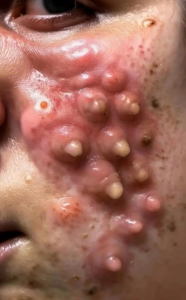Acne is a common skin condition that affects millions of people worldwide, but for some, it can escalate into a severe and distressing issue that requires professional intervention. Recognizing the signs of severe acne and understanding when to seek the expertise of a dermatologist can make a significant difference in managing the condition effectively and preventing long-term complications, such as scarring or emotional distress.

Severe Acne: Identifying the Warning Signs
Not all acne is created equal. While mild acne, such as occasional pimples or blackheads, can often be managed with over-the-counter treatments, severe acne presents more complex challenges. Severe acne is characterized by the presence of cysts, nodules, and deep, painful lesions. These forms of acne penetrate deeper into the skin, often causing inflammation, discomfort, and a higher risk of permanent scarring.
Cysts are large, pus-filled lesions that can be tender to the touch and may persist for weeks. Nodules, on the other hand, are hard, painful lumps beneath the skin’s surface that can take a long time to heal. Deep, painful acne of this nature is not only physically uncomfortable but can also take a toll on a person’s self-esteem and mental well-being. If an individual notices these symptoms, it is a strong indication that their acne has progressed beyond what typical skincare routines or drugstore products can address.
When to See a Dermatologist
For those experiencing severe acne, consulting a dermatologist is a critical step toward effective treatment. Dermatologists are medical professionals specializing in skin health, equipped with the knowledge and tools to diagnose and treat complex skin conditions. A visit to a dermatologist is particularly recommended when acne manifests as cysts, nodules, or deep, painful lesions that do not respond to standard treatments.
Beyond the physical severity, other factors may also warrant professional attention. One such factor is the timing and persistence of acne. While acne is commonly associated with adolescence, it can affect individuals well into adulthood, sometimes appearing for the first time later in life or continuing from teenage years.
Late-Onset Acne: A Growing Concern
Late-onset acne refers to acne that develops in adults who have never experienced the condition during their teenage years. This type of acne can be particularly perplexing, as it may seem to appear out of nowhere. Hormonal changes, stress, dietary factors, or underlying medical conditions can contribute to late-onset acne, making it essential to identify the root cause for effective treatment.
For example, women may experience late-onset acne due to hormonal fluctuations related to menstruation, pregnancy, or menopause. Similarly, certain medications or lifestyle factors, such as high-stress environments or the use of comedogenic (pore-clogging) skincare products, can trigger acne in adulthood. A dermatologist can conduct a thorough evaluation, which may include medical history reviews, skin assessments, or even lab tests, to pinpoint the cause and tailor a treatment plan.
Persistent Acne: When Teenage Acne Lingers
Persistent acne, on the other hand, is defined as acne that continues from adolescence into adulthood or reappears after periods of remission. For some, acne that began in their teenage years never fully resolves, leading to ongoing challenges with breakouts, inflammation, and scarring. Persistent acne can be particularly frustrating, as individuals may feel they have “outgrown” the condition only to face recurring flare-ups.
This type of acne may be influenced by genetic predispositions, hormonal imbalances, or environmental factors. For instance, individuals with a family history of acne may be more prone to persistent symptoms. Additionally, lifestyle factors such as diet, stress, or improper skincare routines can exacerbate the condition. A dermatologist can help by prescribing targeted treatments, such as oral medications, topical retinoids, or advanced therapies like chemical peels or laser treatments, to manage persistent acne effectively.
Why Professional Help Matters
Seeking the guidance of a dermatologist for severe, late-onset, or persistent acne is crucial for several reasons. First, dermatologists can provide access to prescription-strength treatments that are more effective than over-the-counter options. These may include antibiotics, isotretinoin (commonly known as Accutane), or hormonal therapies for those with hormone-related acne.
Second, dermatologists can help prevent long-term damage to the skin. Severe acne, if left untreated, can lead to permanent scarring, hyperpigmentation, or textural changes that are difficult to correct later. Early intervention can minimize these risks and improve overall skin health.
Finally, acne can have a profound impact on mental health, contributing to feelings of embarrassment, anxiety, or depression. A dermatologist not only addresses the physical symptoms but can also offer support and guidance to help patients regain confidence in their appearance.
Taking the Next Step
If you or someone you know is struggling with severe acne characterized by cysts, nodules, or deep, painful lesions, or if you’re experiencing late-onset or persistent acne, it’s time to consider consulting a dermatologist. These professionals can offer personalized treatment plans tailored to the specific needs of your skin, helping you achieve clearer, healthier skin and improved quality of life.
To get started, schedule an appointment with a board-certified dermatologist who can assess your condition and recommend the best course of action. With the right care and expertise, severe and persistent acne can be managed effectively, allowing you to put your best face forward.



